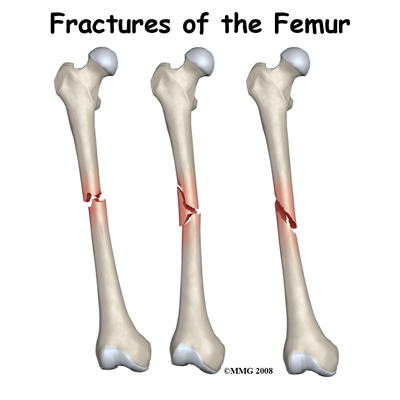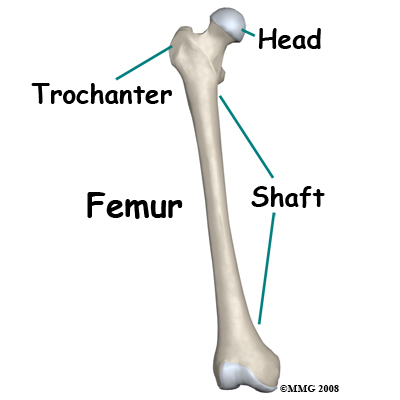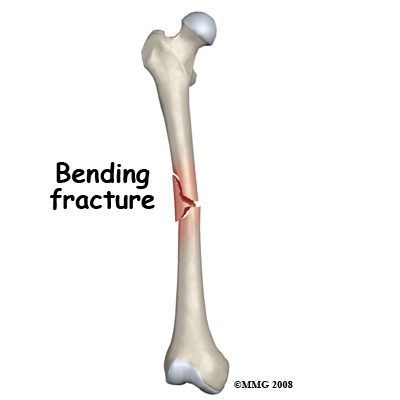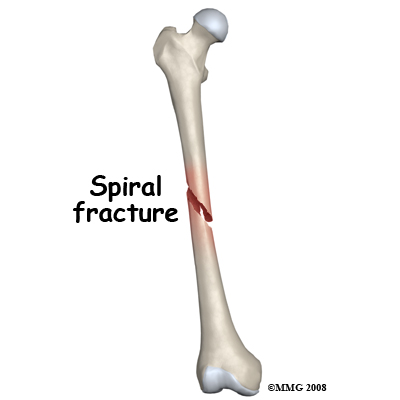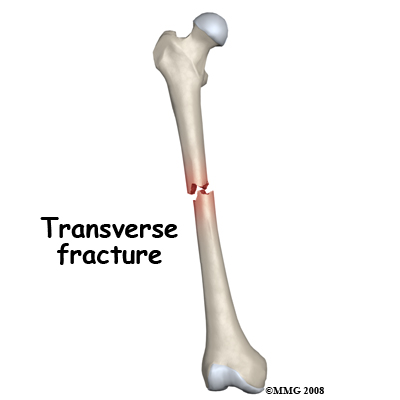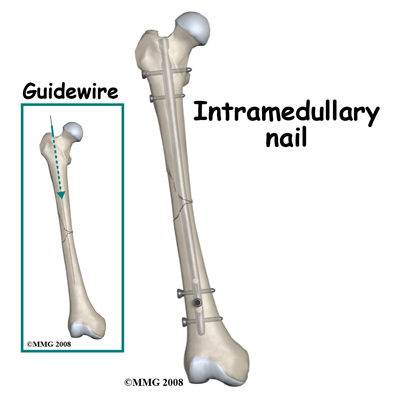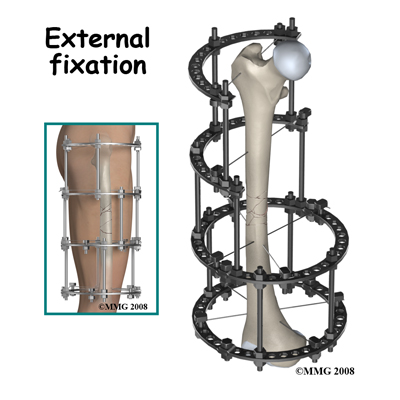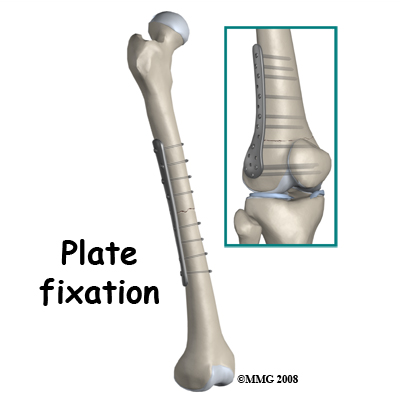What happens as I recover from surgery?
The normal uncomplicated process of bone healing takes six weeks to obtain 50 percent of eventual bone strength, three months to reach 80 percent bone strength and consolidation and remodeling of the fracture site may continue for 18 months. The consequences of this timetable are that the fracture needs protection for the first three months. Early on this means using crutches and not putting much weight through the injured leg otherwise the fixation will fail.
In order to determine when more weight can be put through the thigh your orthopaedic surgeon will monitor the healing with x-rays at intervals. When new bone formation (callus) is evident bridging across the fracture, you may be encouraged to put more weight on the leg. Even though actual bone healing may be at 50 or 80%, overall recovery from the fracture and surgery also requires adequate muscle strength and endurance as well as joint range of motion and control. Physiotherapy at Next Step Physio can help you achieve this.
Rehabilitation at Next Step Physio will begin as soon as your surgeon recommends it. Sometimes therapy will be recommended even before you are allowed to fully weight bear. In other cases, rehabilitation will not be recommended until full or nearly full weight bearing begins. Each surgeon will set his own specific restrictions based on the type of fracture, surgical procedure used, personal experience, and whether the fracture is healing as expected.
Even if physiotherapy for the injured leg has not yet begun, at Next Step Physio we highly recommend maintaining the rest of your body’s fitness with regular exercise. You can use an upper body bike if you are non-weight bearing or may even be advised to do non-weight bearing exercises in a pool. A stationary bike is often the best cardiovascular activity once weight bearing begins. Weights for the upper extremities and other leg are also strongly encouraged. Your physiotherapist at Next Step Physio can provide a program for you to maintain your general fitness while you recover from your surgery.
If you are still using crutches by the time we first see you at Next Step Physio, your physiotherapist will ensure you are using them safely, properly, and confidently and that you are abiding by your weight bearing restrictions. We will also ensure that you can safely use your crutches on stairs. If you are no longer using crutches, or once you no longer need them, your physiotherapist will focus on normal gait re-education. Until you are able to walk without a significant limp, we recommend that you continue to use your crutches, or at least one crutch or a cane/walking stick. Improper gait can lead to a host of other pains in the knee, hip and back so it is prudent to use a walking aid until near normal walking can be achieved. Your Next Step Physio physiotherapist will advise you regarding the appropriate time for you to be walking without any walking aid at all.
Patients may experience pain when they initially start to put weight through their leg. This pain can be from not using the joints and muscles regularly or it may be from concurrent soft tissue injury that occurred when you fractured your thigh. During your first few appointments at Next Step Physio your physiotherapist will focus on relieving your pain. We may use modalities such as heat, ice, ultrasound, or electrical current to assist with decreasing any pain or swelling you have around the surgical site or anywhere down the extremity. In addition, your physiotherapist may massage your leg and ankle to improve circulation and help decrease your pain.
The next part of our treatment will focus on regaining the range of motion and strength in your entire lower limb. Your extremity will look and feel quite weak after not using it for an extended period. Your physiotherapist at Next Step Physio will prescribe a series of stretching and strengthening exercises that you will practice in the clinic and also learn to do as part of your home exercise program. We will focus particularly on gaining range of motion in your knee as the knee can easily become stiff if early motion is not encouraged. In regards to strength we will focus on the muscles of your hip and thigh but may even give you exercises for areas such as your ankle or back as these areas help to support the lower limb when you are weight bearing. An electrical muscle stimulator may be used to assist your muscles in contracting as you do your exercises, which will assist you in more rapidly gaining your strength back. Exercises may also include stationary cycling and the use of Theraband or weights to provide some resistance for your lower leg.
If necessary your physiotherapist will mobilize your joints. This hands-on technique encourages the stiff joints of your hip, knee, ankle and foot to move gradually into their normal range of motion. Mobilization of the joints may be combined with assisted stretching of any tight muscles around the surgical site. Fortunately, the initial phases of gaining range of motion and strength after a femur fracture go quickly. You will notice improvements in the functioning of your whole leg even after just a few treatments with your physiotherapist at Next Step Physio. As your range of motion and strength improve, we will advance your exercises to ensure your rehabilitation is progressing as quickly as your body allows.
As a result of any injury, the receptors in your joints and ligaments that assist with balance and proprioception (the ability to know where your body is without looking at it) decline in function. A period of immobility and reduced weight bearing will add to this decline. If your balance and proprioception has declined, your joints and your limb as a whole will not be as efficient in its functioning and the decline may also contribute to a potential injury in the future. As a final component of our treatment your physiotherapist at Next Step Physio will prescribe exercises for you to regain balance and proprioception. These exercises might include activities such as standing on one foot or balancing on an unstable surface such as a wobble board or a soft plastic disc. Advanced exercises will include agility type exercises such as hopping, jumping or moving side to side. Eventually we will encourage exercises that mimic the quick motions of the sports or activities that you enjoy participating in.
Once the fracture shows x-ray signs of consolidation you can use the leg more normally and return to heavier activities and sports. This stage is usually between three and 18 months post-injury and depends just as much on the recovery of muscle strength and endurance as it does on the recovery of the bone. The fact that the healing process may go on for 18 months means that the symptoms of aching, throbbing, swelling and weakness may continue for a long time after the bone appears 'healed' on x-ray but should gradually decline and then disappear.
Generally, the strength and stiffness one experiences after surgery to repair a femur fracture responds very well to the physiotherapy we provide at Next Step Physio, however, if your pain continues longer than it should or therapy is not progressing as your physiotherapist at Next Step Physio would expect, we will ask you to follow-up with your surgeon to confirm that the surgical site is tolerating the rehabilitation well and ensure that there are no hardware issues or complications that may be impeding your recovery.
Overall the prognosis for full recovery from a fractured thigh bone is encouraging. Most people’s bones heal in a good position and they recover near normal function. Most of those who do not recover full function have had the injury or its treatment complicated by one or more of the problems discussed in the next section.
Next Step Physio provides services for physiotherapy in Edmonton.
